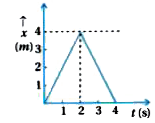A cyclist moving on level circular path of radius 4 m with speed of 4.9 m/s takes sharp turn. Co-efficient of friction between tyre and road will b e .......Solution in Gujrati
0.51
0.41
0.71
0.61
The correct Answer is:D
Let cyclist moves with speed v on circular path of radius r and take sharp turn let co- efficient of friction be μ
μ=tanθ=v2rg
μ=0.61
Topper's Solved these Questions
- BOOK - KUMAR PRAKASHANCHAPTER - LAW OF MOTIONEXERCISE - (QUESTION PAPER) SECTION-A5videos
LAW OF MOTION
- BOOK - KUMAR PRAKASHANCHAPTER - LAW OF MOTIONEXERCISE - (QUESTION PAPER) SECTION-B2videos
LAW OF MOTION
- BOOK - KUMAR PRAKASHANCHAPTER - LAW OF MOTIONEXERCISE - SECTION -E(MULTIPLE CHOICE QUESTIONS) (MCQS)69videos
LAW OF MOTION
- BOOK - KUMAR PRAKASHANCHAPTER - GRAVITATIONEXERCISE - QUESTIONS PAPER Section - D1videos
GRAVITATION
- BOOK - KUMAR PRAKASHANCHAPTER - MACHANICAL PROPERTIES OF SOLIDS EXERCISE - QUESTION PAPER11videos
MACHANICAL PROPERTIES OF SOLIDS
Similar Questions
What is dynamics?
02:25View SolutionWhat are concurrent forces ?
03:08View SolutionThe position (x) → time (t) graph of one dimensional motion of a body of mass 0.4 kg. What is the magnitude of impulse of force
 03:26View Solution
03:26View SolutionA spaceship is stationed on Mars. How much energy must be expended on the spaceship to launch it out of the solar system ? Mass of the spaceship = 1000 kg, mass of the sun =2×1030kg, mass of mars =6.4×1023kg, radius of mars = 3395 km, radius of the orbit of mars =2.28×108km,G=6.67×10−11Nm2kg2
03:53View SolutionWhat is called brittle material ?
10:35View SolutionA cyclist speeding at 18km/h on a level road takes a sharp circular turn of radius 3 m without reducing the speed . The coefficient of static friction between the tyres and the road is 0.1 Will the cyclist slip while taking the turn ?
06:02View SolutionIf a cyclist moving with a speed of 4.9m/s on a level road can take a sharp circular turn of radius 4 m , then coefficient of friction between the cycle tyres and road is
01:57View SolutionA cyclist on a level road takes a sharp circular turn of radius 3 m (g = 10 ms^(-2) ). If the coefficient of static friction between the cycle tyres and the road is 0.2, at which of the following speeds will the cyclist not skid while taking the turn?
06:16View SolutionA cyclist speeding at 18 km/h on a level rod takes a sharp circular turn of radius 3 m without reducing the speed and without spending towards the centre of the circular path. The coefficient of static friction between the tyres and the road is 0.1. Will the cyclist slip while taking the turn?
03:45View SolutionCalculate the maximum speed with which a vehicle can travel on a banked circular road without skidding. A cyclist at a 18 km/h on a level road takes a sharp turn of radius 3 m without reducing the speed. The coefficient of static friction between the tyres and the road is 1. Will cyclist slip while taking the turn?
01:57View SolutionA cyclist speeding at 18 km/h on a level road takes a sharp circular turn of radius 3 m without reducing the speed. The co-efficient of static friction between the tyres and the road is 0.1. Will the cyclist slip while taking the turn?
03:22View SolutionA cyclist speeding at 18 km/h on a level road takes a sharp circular turn of radius 3 m without reducing the speed. The co-efficient of static friction between the tyres and the road is 0.1. Will the cyclist slip while taking the turn?
01:57View SolutionA cyclist speeding at 18 km/h on a level road takes a sharp circular turn of radius 3 m without reducing the speed. The co-efficient of static friction between the tyres and the road is 0.1. Will the cyclist slip while taking the turn?
01:20View Solutionएक समतल सड़क पर 4.9 मीटर/सैकण्ड की चाल से गतिमान साईकिल सवार 4 मीटर त्रिज्या के तीक्षण वृताकार मोड़ पर मूड सकता है। तब साईकिल के टायरों तथा सड़क के बीच घर्षण गुणांक है
03:05View SolutionA cyclist speeding at 18 km/h on a level road takes a sharp circular turn of radius 3 m without reducing the speed. The co-efficient of static friction between the tyres and the road is 0.1. Will the cyclist slip while taking the turn?
03:00View Solution

